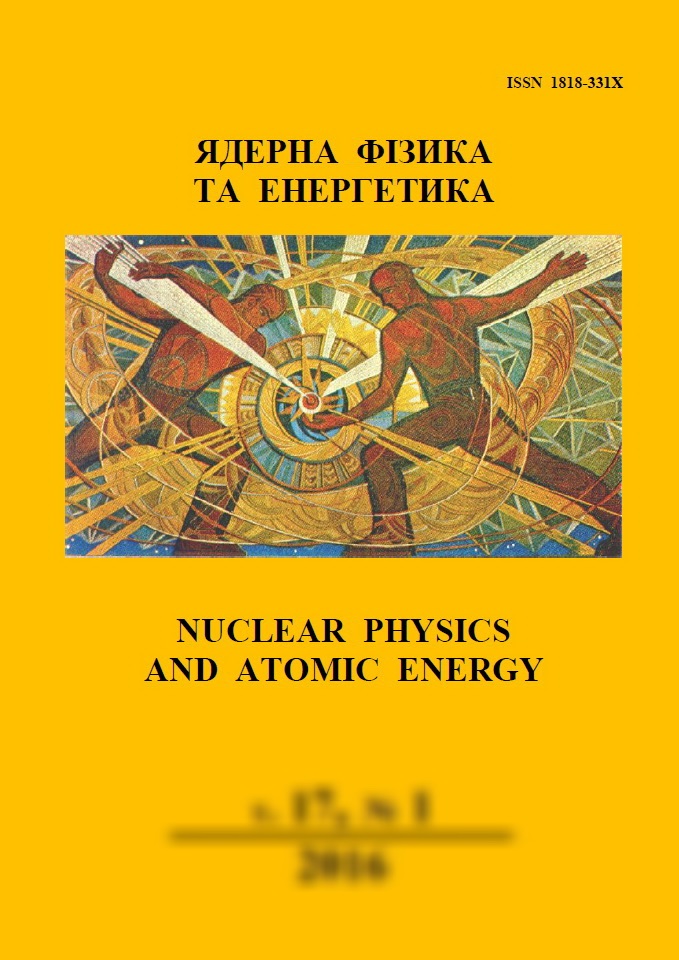 |
ßäåðíà ô³çèêà òà åíåðãåòèêà
Nuclear Physics and Atomic Energy
ISSN:
1818-331X (Print), 2074-0565 (Online)
Publisher:
Institute for Nuclear Research of the National Academy of Sciences of Ukraine
Languages:
Ukrainian, English
Periodicity:
4 times per year
Open access peer reviewed journal
|
Nucl. Phys. At. Energy 2025, volume 26, issue 2, pages 155-161.
Section: Nuclear Physics.
Received: 21.01.2025; Accepted: 24.05.2025; Published online: 24.06.2025.
 Full text (en)
Full text (en)
https://doi.org/10.15407/jnpae2025.02.155
Longitudinal development of gamma-ray extensive air shower in the knee and ankle energy ranges
Z. A. Nasser, I. F. Hussein*, A. A. Al-Rubaiee
Mustansiriyah University, College of Science, Department of Physics, Baghdad, Iraq
*Corresponding author. E-mail address:
itabfadhil@uomustansiriyah.edu.iq
Abstract:
Identifying the longitudinal profile of extensive air showers (EAS) is crucial for investigating the origin and characteristics of ultra-high-energy cosmic rays. This study simulates gamma-ray-induced EAS in the knee 1015 eV and ankle 1018 - 1020 eV energy ranges using the AIR-shower Extended Simulations (AIRES) system (Version 19.04.10) with QGSJET II 04 and EPOS LHC hadronic models at zenith angles of 0° and 25°. The shower patterns are parameterized using a Gaussian amplitude function, which reveals that the shower maximum Xmax develops logarithmically with primary energy. Gamma-ray density peaks in deeper atmospheric layers ∼580 - 864 g/cm2 for higher energies. Particularly, slanted showers 25° display wider particle distributions due to longer atmospheric path lengths, which is consistent with CORSIKA. These findings limit the harmonic interaction models for the Telescope Array and LHAASO experiments, thereby reducing systematic errors in cosmic ray composition analysis.
Keywords:
gamma-ray, longitudinal development, AIRES system, knee and ankle regions, extensive air shower.
References:
1. J.A. Simpson. Elemental and isotopic composition of the galactic cosmic rays. Ann. Rev. Nucl. Part. Sci. 33 (1983) 323.
https://doi.org/10.1146/annurev.ns.33.120183.001543
2. S. Knurenko et al. Cerenkov radiation of cosmic ray extensive air showers. Part 3. Longitudinal development of showers in the energy region of 1015 - 1017 eV. Proceedings of the 27th International Cosmic Ray Conference, 07 - 15 August 2001, Hamburg, Germany, p. 157.
https://adsabs.harvard.edu/full/2001ICRC....1..157K
3. K.-H. Kampert. Methods of determination of the energy and mass of primary cosmic ray particles at extensive air shower energies. J. Phys. G 27 (2001) 1663.
https://doi.org/10.1088/0954-3899/27/7/321
4. E. Fermi. On the origin of the cosmic radiation. Phys. Rev. 75 (1949) 1169.
https://doi.org/10.1103/PhysRev.75.1169
5. B. Peters. Primary cosmic radiation and extensive air showers. Nuovo Cim. 22 (1961) 800.
https://doi.org/10.1007/BF02783106
6. L.J. Schultz. Image reconstruction and material Z discrimination via cosmic ray muon radiography. Nucl. Instrum. Methods A 519 (2004) 687.
https://doi.org/10.1016/j.nima.2003.11.035
7. W. Heitler. The Quantum Theory of Radiation. 3rd ed. (London: Oxford University Press, 1954) p. 386.
Google books
8. E.-J. Ahn et al. Cosmic ray event generator Sibyll 2.1. Phys. Rev. D 80 (2009) 094003.
https://doi.org/10.1103/PhysRevD.80.094003
9. P.K.F. Grieder. Extensive Air Showers. High Energy Phenomena and Astrophysical Aspects - A Tutorial, Reference Manual and Data Book (Berlin: Springer-Verlag, 2010).
https://doi.org/10.1007/978-3-540-76941-5
10. A. Acharyya et al. VTSCat: The VERITAS catalog of gamma-ray observations. Res. Notes Am. Astron. Soc. 7 (2023) 6.
Repetition of the Ref. [15].
https://doi.org/10.3847/2515-5172/acb147
11. F. Zhang et al. Study of the longitudinal development of air showers in the knee energy range. Astropart. Phys. 152 (2023) 102877.
https://doi.org/10.1016/j.astropartphys.2023.102877
12. M. Risse et al. Primary particle type of the most energetic Fly’s Eye air shower. Astropar. Phys. 21(4) (2004) 479.
https://doi.org/10.1016/j.astropartphys.2004.04.003
13. J.A. Hinton (For the HESS Collaboration). The status of the HESS project. New Astron. Rev. 48(5-6) (2004) 331.
https://doi.org/10.1016/j.newar.2003.12.004
14. Z. Cao (on behalf of LHAASO Collaboration). LHAASO status and physics results. EPJ Web Conf. 280 (2023) 01003.
https://doi.org/10.1051/epjconf/202328001003
15. A.A. Al-Rubaiee. Extension of Cherenkov Light LDF Parametrization for Tunka and Yakutsk EAS Arrays. J. Astrophys. Astr. 35 (2014) 631.
https://doi.org/10.1007/s12036-014-9305-x
16. V. Verzi, D. Ivanov, Y. Tsunesada. Measurement of energy spectrum of ultra-high energy cosmic rays. Prog. Theor. Exp. Phys. 12 (2017) 12A103.
https://doi.org/10.1093/ptep/ptx082
17. W. Hofmann, R. Zanin. The Cherenkov Telescope Array. arXiv:2305.12888 (2023).
https://doi.org/10.48550/arXiv.2305.12888
18. W. Heitler. Theory of Meson Production. Rev. Mod. Phys. 21 (1949) 113.
https://doi.org/10.1103/RevModPhys.21.113
19. K.-H. Kampert, A.A Watson. Extensive air showers and ultra high-energy cosmic rays: a historical review. Eur. Phys. J. H 37 (2012) 359.
https://doi.org/10.1140/epjh/e2012-30013-x
20. Cosmic-rays air showers.
https://www.mpi-hd.mpg.de/hfm/CosmicRay/Showers.html
21. A. Haungs, H. Rebel, M. Roth. Energy spectrum and mass composition of high-energy cosmic rays. Rep. Prog. Phys. 66 (2003) 1145.
https://doi.org/10.1088/0034-4885/66/7/202
22. S.J. Sciutto. AIRES User’s Manual and Reference Guide (Version 19.04.10) (Argentina, La Plata, 2023) 240 p.
http://aires.fisica.unlp.edu.ar/doc/airesmanual/UsersManual190410.pdf
23. H. Rebel, O. Sima. Information about high-energy hadronic interaction processes from extensive air shower observations. Rom. J. Phys. 57(1-2) (2012) 472.
https://rjp.nipne.ro/2012_57_1-2/RomJPhys.57.p472.pdf
24. W. Heitler. Cascade Showers. In: Quantum Theory of Radiation. 2nd ed. Chapter 5 (Oxford University Press, 1944) p. 232.
https://web.mit.edu/8.13/8.13c/references-fall/muons/rossi-high-energy-particles-1952-ch5-cascade-showers.pdf
25. S.J. Sciutto. The AIRES system for air shower simulations. An update. arXiv:astro-ph/0106044v1 (2001).
https://doi.org/10.48550/arXiv.astro-ph/0106044
26. I.F. Hussein, A.A. Al-Rubaiee. Estimating the longitudinal development of atmospheric cascades at high energies. AIP Conf. Proc. 2591 (2023) 030072.
https://doi.org/10.1063/5.0121384
27. T.Z. Abuzayyad. The energy spectrum of ultra high energy cosmic rays. PhD Thesis (University of Utah, 2000) 138 p.
https://ui.adsabs.harvard.edu/abs/2000PhDT.........5A/abstract
28. I.F. Hussein, A.A. Al-Rubaiee. Simulating and modelling the extensive air showers development through the estimating the energy of some created particles. Al-Mustansiriyah J. Sci. 33(3) (2022) 1137.
https://doi.org/10.23851/mjs.v33i3.1137
29. The Pierre Auger Collaboration. The Pierre Auger Cosmic Ray Observatory. Nucl. Instrum. Methods A 798 (2015) 172.
https://doi.org/10.1016/j.nima.2015.06.058
30. M. Takeda et al. Extension of the cosmic-ray energy spectrum beyond the predicted Greisen-Zatsepin-Kuz'min cutoff. Phys. Rev. Lett. 81(7) (1998) 1163.
https://doi.org/10.1103/PhysRevLett.81.1163
31. D. Heck et al. CORSIKA: A Monte Carlo Code to Simulate Extensive Air Showers (Karlsruhe, Forschungszentrum Karlsruhe, 1998) 90 p.
https://inspirehep.net/files/9bdb7ea99706d9ae48d0be29f9e19f11
